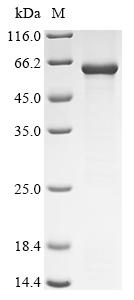Recombinant Rat RanBP-type and C3HC4-type zinc finger-containing protein 1 (Rbck1)
CAT:
399-CSB-EP720325RA-01
Size:
1 mg
Price:
Ask
- Availability: 24/48H Stock Items & 2 to 6 Weeks non Stock Items.
- Dry Ice Shipment: No




Recombinant Rat RanBP-type and C3HC4-type zinc finger-containing protein 1 (Rbck1)
- CAS Number: 9000-83-3
- Gene Name: Rbck1
- UniProt: Q62921
- Expression Region: 1-508aa
- Organism: Rattus norvegicus
- Target Sequence: MDEKTKKAEEMALSLARAVTGGDEQAAIKYATWLAEQKVPLRVQVKPEVSPTQDIRLCVSVEDAYMHTVTIWLTVRPDMTVASLKDMVFLDYGFPPSLQQWVVGQRLARDQETLHSHGIRRNGDSAYLYLLSARNTSLNPQELQRQRQLRMLEDLGFKDLTLQPRGPLEPVLPKPRTHQETGQPDAAPESPPVGWQCPGCTFINKPTRPGCEMCCRARPEAYQIPASYQPDEEERARLAGEEEALRQYEQRKQQQQEGNYLQHVQLEQRSLVLNTEPAECPVCYSVLAPGEAVVLRECLHTFCRECLQGTIRNSQEAEVSCPFIDNTYSCPGKLLEREIRALLSPEDYQRFLDLGVSIAENRSTLSYHCKTPDCRGWCFFEDDVNEFTCPVCTRVNCLLCKAIHERMNCREYQDDLAHRARNDVAAQQTTEMLRVMLQQGEAMYCPQCRIVVQKKDGCDWIRCTVCHTEICWVTKGPRWGPGGPGDTSGGCRCRVNGIPCHPSCQNCH
- Tag: N-terminal 10xHis-tagged and C-terminal Myc-tagged
- Source: E.coli
- Field of Research: Others
- Assay Type: In Stock Protein
- Relevance: E3 ubiquitin-protein ligase, which accepts ubiquitin from specific E2 ubiquitin-conjugating enzymes, such as UBE2L3/UBCM4, and then transfers it to substrates. Functions as an E3 ligase for oxidized IREB2 and both heme and oxygen are necessary for IREB2 ubiquitination. Promotes ubiquitination of TAB2 and IRF3 and their degradation by the proteasome. Component of the LUBAC complex which conjugates linear ('Met-1'-linked) polyubiquitin chains to substrates and plays a key role in NF-kappa-B activation and regulation of inflammation. LUBAC conjugates linear polyubiquitin to IKBKG and RIPK1 and is involved in activation of the canonical NF-kappa-B and the JNK signaling pathways. Linear ubiquitination mediated by the LUBAC complex interferes with TNF-induced cell death and thereby prevents inflammation. LUBAC is recruited to the TNF-R1 signaling complex (TNF-RSC) following polyubiquitination of TNF-RSC components by BIRC2 and/or BIRC3 and to conjugate linear polyubiquitin to IKBKG and possibly other components contributing to the stability of the complex. The LUBAC complex is also involved in innate immunity by conjugating linear polyubiquitin chains at the surface of bacteria invading the cytosol to form the ubiquitin coat surrounding bacteria. LUBAC is not able to initiate formation of the bacterial ubiquitin coat, and can only promote formation of linear polyubiquitins on pre-eXIsting ubiquitin. The bacterial ubiquitin coat acts as an 'eat-me' signal for xenophagy and promotes NF-kappa-B activation. Together with OTULIN, the LUBAC complex regulates the canonical Wnt signaling during angiogenesis. Binds polyubiquitin of different linkage types.
- Purity: Greater than 85% as determined by SDS-PAGE.
- Activity: Not Test
- Length: Full Length
- Form: Liquid or Lyophilized powder
- Buffer: If the delivery form is liquid, the default storage buffer is Tris/PBS-based buffer, 5%-50% glycerol. If the delivery form is lyophilized powder, the buffer before lyophilization is Tris/PBS-based buffer, 6% Trehalose, pH 8.0.
- Reconstitution: We recommend that this vial be briefly centrifuged prior to opening to bring the contents to the bottom. Please reconstitute protein in deionized sterile water to a concentration of 0.1-1.0 mg/mL.We recommend to add 5-50% of glycerol (final concentration) and aliquot for long-term storage at -20℃/-80℃. Our default final concentration of glycerol is 50%. Customers could use it as reference.
- Molecular Weight: 65.1 kDa
- References & Citations: "Accumulation of polyubiquitinated proteins by overexpression of RBCC protein interacting with protein kinase C2, a splice variant of ubiquitin ligase RBCC protein interacting with protein kinase C1." Yoshimoto N., Tatematsu K., Okajima T., Tanizawa K., Kuroda S. FEBS J 276:6375-6385 (2009)
- Storage Conditions: The shelf life is related to many factors, storage state, buffer ingredients, storage temperature and the stability of the protein itself. Generally, the shelf life of liquid form is 6 months at -20℃/-80℃. The shelf life of lyophilized form is 12 months at -20℃/-80℃.
